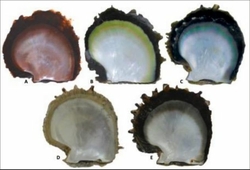WHY ARE THE PEARLS BLACK?
Published by https://www.huffingtonpost.fr/ in PRESS the 03/23/2021 at 04:32 pm

SCIENCE
03/22/2021 12:29 GMT
Why are black pearls black? Researchers have found the answer
How do Polynesian pearls acquire their magnificent black hue? It depends on the genes of the pearl oysters but also on the depth to which they were reared, reveal researchers from Ifremer.

The color of Polynesian pearls is determined by genetic and environmental factors.
SEA - The brilliance of their dark hue, a rainbow of dark shades between yellow, red and green, made them famous. The black pearls produced by Polynesian oysters are, along with their golden Australian cousins, the pearly gems of Oceania. But how do Polynesian pearls acquire their unique black color? Two Ifremer research papers attempted to answer it, a statement from the research institute released on March 22 revealed.
The first factor is genetic, according to the study by Dr. Pierre-Louis Stenger, a specialist in pearl oyster genomics. A pearl is produced from a graft between two oysters, Ifremer explains. The color of a pearl produced is similar to that of the inside of the donor oyster shell, the transplant being the carrier of the latter's genetic makeup.
“Cocktail of genes”
The researchers therefore wanted to sequence the genome of oysters producing precise colors. And they were able to identify the different genes activated according to the color produced: seven genes in pearl oysters with a yellow internal shell, 19 are associated with green, and 24 with red.

The color of Polynesian pearls is determined by genetic and environmental factors.
SEA - The brilliance of their dark hue, a rainbow of dark shades between yellow, red and green, made them famous. The black pearls produced by Polynesian oysters are, along with their golden Australian cousins, the pearly gems of Oceania. But how do Polynesian pearls acquire their unique black color? Two Ifremer research papers attempted to answer it, a statement from the research institute released on March 22 revealed.
The first factor is genetic, according to the study by Dr. Pierre-Louis Stenger, a specialist in pearl oyster genomics. A pearl is produced from a graft between two oysters, Ifremer explains. The color of a pearl produced is similar to that of the inside of the donor oyster shell, the transplant being the carrier of the latter's genetic makeup.
“Cocktail of genes”
The researchers therefore wanted to sequence the genome of oysters producing precise colors. And they were able to identify the different genes activated according to the color produced: seven genes in pearl oysters with a yellow internal shell, 19 are associated with green, and 24 with red.

Identification and traceability of your Pearl
Order in complete security
By your side 7/7!
Fast Shipping & Delivery
Powered by Wizishop
